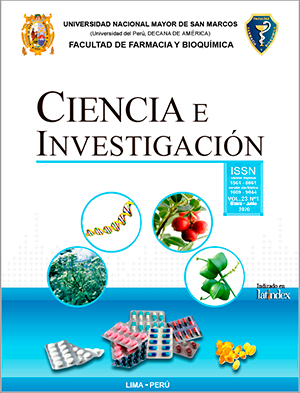Polyphenols and antioxidant activity of aqueous extract of Musa Acuminata Cavendish Subgroup (BANANA)
DOI:
https://doi.org/10.15381/ci.v23i1.18717Keywords:
Musa acuminata Cavendish Subgroup, polyphenols, DPPHAbstract
The objective of this work was to determine the total polyphenol content and evaluate the antioxidant activity by the 2,2-diphenyl-1-picrilhydrazil (DPPH) method in a lyophilized aqueous extract of the Musa canvedish “Banana” peel. The treatment of 300 g of the sample was carried out by running through water at 90 ° C for 20 seconds, immediately 500 ml of a mixture of water and 96% ethanol in a ratio (1:1) were added, immediately crushing was performed, centrifugation and filtration of the diluted sample. The ethanol fraction was separated with the use of a rotary evaporator for subsequent lyophilization of the liquid fraction. The quantification of polyphenols was performed using the Folin Ciocalteu method and the antioxidant activity was used by the DPPH radical method. All tests are performed in triplicate, calculating the standard deviation and the multiple comparisons test for antioxidant activity. The total polyphenol content was 5,7811 µg equivalent of gallic acid / 1g of Musa acuminata Cavendish Subgroup extract. The percentage of inhibition by the DPPH radical method with a percentage of 33,333; fifty; 66,667 and 100 µg / mL were 20,959; 31,428; 41,030 and 60,290%, respectively. The mean inhibitory concentration was (IC 50) of 81.95 µg / mL. It is concluded that the lyophilized extract of Musa canvedish “Banana” has polyphenols and moderate antioxidant activity, being an interesting sample for future research.
Downloads
Published
Issue
Section
License
Copyright (c) 2020 María Marín-Velázquez

This work is licensed under a Creative Commons Attribution-NonCommercial-ShareAlike 4.0 International License.
LOS AUTORES RETIENEN SUS DERECHOS:
- Los autores retienen sus derechos de marca y patente, y tambien sobre cualquier proceso o procedimiento descrito en el artículo.
- Los autores retienen el derecho de compartir, copiar, distribuir, ejecutar y comunicar públicamente el articulo publicado en la Revista Ciencia e Investigación (por ejemplo, colocarlo en un repositorio institucional o publicarlo en un libro), con un reconocimiento de su publicación inicial en la Revista Ciencia e Investigación.
- Los autores retienen el derecho a hacer una posterior publicación de su trabajo, de utilizar el artículo o cualquier parte de aquel (por ejemplo: una compilación de sus trabajos, notas para conferencias, tesis, o para un libro), siempre que indiquen la fuente de publicación (autores del trabajo, revista, volumen, numero y fecha).






